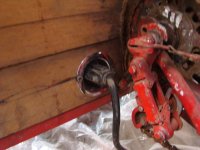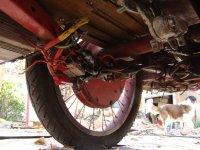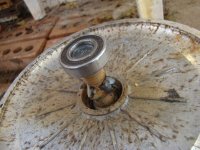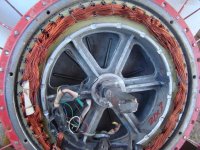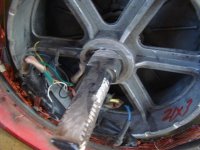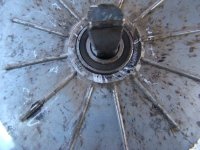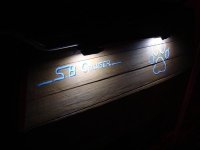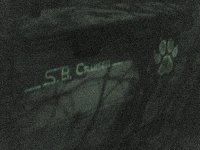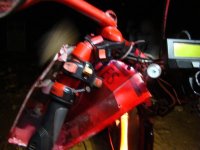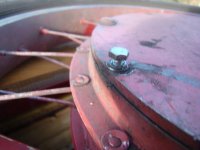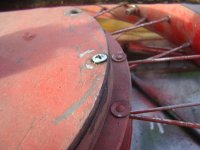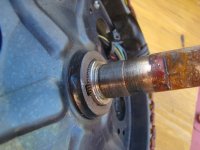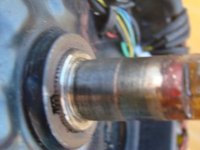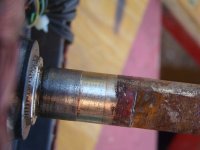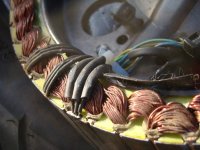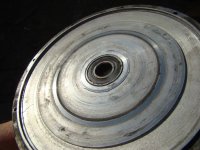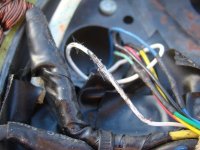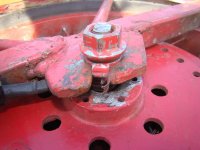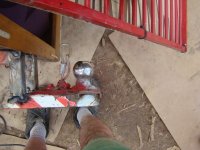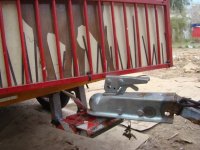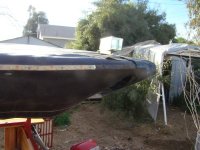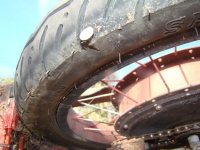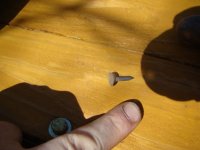So far, at night, I'm getting anywhere from no change to several feet more room behind me both while moving and stopped at a light, with the new lights on the rear (and the old ones removed).
No change in daytime, but I didn't expect any. Even in daytime, when the lights are significantly less visible (a concentrated spot of light does work better in daytime than at night, as it isn't blinding with all the other light already there), the brake and turn signals still work to communicate with others on the road, just as the DOT stuff did before.
I am considering a couple of changes to the system, however, which will need some electronics development. Simple stuff, but have to work it out and possibly do some experimenting.
I'd like to put a light sensor on the trike, probably underneath it near the center, so that when there is sufficient light from daylight hitting it, it would turn off the taillights (or dim them extremely), for better contrast with the brake lights (which brighten the taillights to full as well as turning on separate brake-only strips), and with the turn signals that are immediately parallel to the taillights.
I'd also like to make the tail and brake lights dim or even cut out entirely, during a turn signal, on the side the signal is flashing on, for the strips that are immediately parallel to the turn signals. This would be for day or night use.
The light sensor would probably just be a photocell in a voltage dividier biasing a transistor in series with the light strips I want dimmed or brigthened. I have photocells in various old self-dimming lamp fixtures (meant for nightlights that sit directly at the outlets), where the fixtures don't work anymore (bad SCRs probably). I have plenty of transistors of assorted power ratings, and heatsinks if I need them.
The other electronic switch would also just be biasing that transistor above, possibly with a diode from the turn signal power to force the transistor off. Dunno yet, have to draw it out to find the lowest-component easiest design I can make with what I already have.
What makes it a bit more complicated is that I'd like it not to blink the tail/brake in opposition to the turn, which is what I *do* want to happen to the side marker lights, but rather to simply turn off the tail/brake on those strips until the turn signal is turned off. I can probably do this with a capacitor that is charged by the turn signal voltage, that whent eh signal shuts off drains down to the point where the tail/brake can turn back on about the same time a new turn signal pulse would come along, so they never get to turn back on until the pulses stop coming in. If I can't do it with a straight cap, I can use a 555 timer in one-shot mode, but that's mroe complicated (which usually means it's more prone to failure).
Have run into a couple of problems with the front end:
The speedo sensor wire appears to ahve broken somewhere along the area behind the headlight before it goes up the tiller. If I touch it along that area it sometimes starts working again, but whenever I move the tiller it stops. No idea why it would have failed; it worked fine on my way to work yesterday, and didnt' work on the way home. No signs of anyone messing with it, so I guess it just failed between those times. Need to find the bad spot and splice around it.
The narrower rim causes worse brake rub from the back-front set of pads, due to the angle the bosses are at vs the fork/rim (since they're bolted to teh *back* of the fork rather than the front). It causes the back tips of the pads to rest against the rim all the time even when the cable is so loose you can't even brake at all with them. No such problem with the front-front pads, as those bosses are at the normal angle. This was a bit of an issue with the wider rim, but not nearly as much as it is with the narrower rim, because narrower causes the pads to be at more of a splayed angle to be where they can sit that braking properly clamps them against the rim.
Only fix for this is to do what I planned back when I put the second set of brakes on the fork, whcih is to make a "wedge" cup on the back fo each end of the boss-arch to chagne the angle the assembl sits against teh fork legs, to force teh bosses to be parallel with the rim like the frotn ones are. Not sure when this will happen.
Until it does, then keeping the pads where they have to be to allow full braking means pad wear on the rear tips, and a noticeable loss of efficiency (couple wh/mile!).
No change in daytime, but I didn't expect any. Even in daytime, when the lights are significantly less visible (a concentrated spot of light does work better in daytime than at night, as it isn't blinding with all the other light already there), the brake and turn signals still work to communicate with others on the road, just as the DOT stuff did before.
I am considering a couple of changes to the system, however, which will need some electronics development. Simple stuff, but have to work it out and possibly do some experimenting.
I'd like to put a light sensor on the trike, probably underneath it near the center, so that when there is sufficient light from daylight hitting it, it would turn off the taillights (or dim them extremely), for better contrast with the brake lights (which brighten the taillights to full as well as turning on separate brake-only strips), and with the turn signals that are immediately parallel to the taillights.
I'd also like to make the tail and brake lights dim or even cut out entirely, during a turn signal, on the side the signal is flashing on, for the strips that are immediately parallel to the turn signals. This would be for day or night use.
The light sensor would probably just be a photocell in a voltage dividier biasing a transistor in series with the light strips I want dimmed or brigthened. I have photocells in various old self-dimming lamp fixtures (meant for nightlights that sit directly at the outlets), where the fixtures don't work anymore (bad SCRs probably). I have plenty of transistors of assorted power ratings, and heatsinks if I need them.
The other electronic switch would also just be biasing that transistor above, possibly with a diode from the turn signal power to force the transistor off. Dunno yet, have to draw it out to find the lowest-component easiest design I can make with what I already have.
What makes it a bit more complicated is that I'd like it not to blink the tail/brake in opposition to the turn, which is what I *do* want to happen to the side marker lights, but rather to simply turn off the tail/brake on those strips until the turn signal is turned off. I can probably do this with a capacitor that is charged by the turn signal voltage, that whent eh signal shuts off drains down to the point where the tail/brake can turn back on about the same time a new turn signal pulse would come along, so they never get to turn back on until the pulses stop coming in. If I can't do it with a straight cap, I can use a 555 timer in one-shot mode, but that's mroe complicated (which usually means it's more prone to failure).
Have run into a couple of problems with the front end:
The speedo sensor wire appears to ahve broken somewhere along the area behind the headlight before it goes up the tiller. If I touch it along that area it sometimes starts working again, but whenever I move the tiller it stops. No idea why it would have failed; it worked fine on my way to work yesterday, and didnt' work on the way home. No signs of anyone messing with it, so I guess it just failed between those times. Need to find the bad spot and splice around it.
The narrower rim causes worse brake rub from the back-front set of pads, due to the angle the bosses are at vs the fork/rim (since they're bolted to teh *back* of the fork rather than the front). It causes the back tips of the pads to rest against the rim all the time even when the cable is so loose you can't even brake at all with them. No such problem with the front-front pads, as those bosses are at the normal angle. This was a bit of an issue with the wider rim, but not nearly as much as it is with the narrower rim, because narrower causes the pads to be at more of a splayed angle to be where they can sit that braking properly clamps them against the rim.
Only fix for this is to do what I planned back when I put the second set of brakes on the fork, whcih is to make a "wedge" cup on the back fo each end of the boss-arch to chagne the angle the assembl sits against teh fork legs, to force teh bosses to be parallel with the rim like the frotn ones are. Not sure when this will happen.
Until it does, then keeping the pads where they have to be to allow full braking means pad wear on the rear tips, and a noticeable loss of efficiency (couple wh/mile!).



